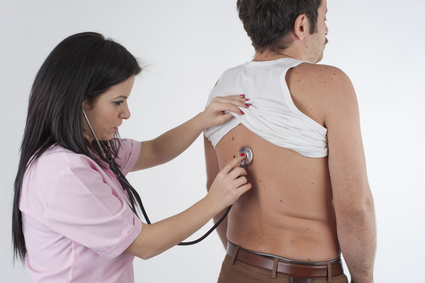
I recently worked with a nursing student from a local university in the hospital where I practice.
I had him perform the physical assessment so I could assess his ability to perform this basic nursing assessment skill that he had already done repeatedly in the clinical setting.
I noticed that he listened to breath sounds on one side first before auscultating the other side, instead of comparing each side to the other.
He did not know how to accurately assess for pitting edema and how to grade from 1+ to 4+.
When listening to the chest for cardiac heart sounds, he intentionally listened only to the apical area, but did not know if he was listening to the aortic, pulmonic, mitral, or tricuspid valve.
These shortcomings if allowed to continue would hinder his ability to accurately collect clinical data and be “practice ready” as a student nurse as well as in practice.
Priority of Practice Readiness
Practice readiness is a current struggle in nursing education with only 23% of graduate nurses being able to demonstrate acceptable levels of clinical reasoning according to a recent study published this year.
Practice readiness must also encompass and ensure that students are able to utilize correctly the most important assessment skills to the bedside (see recent blog Crisis in Competency).
Nursing students are overwhelmed with the amount of content they are expected to master and as a result struggle to use and apply the most important content to practice.
Another area that this is a problem is in how physical assessment is currently taught in some programs.
Not a Unique Struggle
Nursing students struggle to complete a thorough physical assessment and understand the rationale for clinical data they collect.
Though this is to be expected from an inexperienced novice nurse, it is important for nurse educators to recognize that they may be part of the problem because of how physical/health assessment is currently taught.
Though Jean Giddens (2007) identified that there are only 30 physical assessment skills that nurses use in the clinical setting, students in some programs are taught well over 100 specific assessment skills, most are rarely if ever used.
As a result, students acquire a superficial knowledge of physical assessment skills, but not the DEEP learning of the 30 assessment skills that they will use regularly in practice.
In the recently published article Physical Assessment Techniques in Nursing Education: A Replicated Study, the authors took a closer look at how nursing assessment was taught at one baccalaureate nursing program in the midwestern United States.
Of 126 physical assessment skills that were taught in this program, only 30 were used regularly by students in the clinical setting.
The study concluded that:
“Nurse educators must continue to DISCRIMINATE content taught in prelicensure nursing education programs and should consider the attainment of competency of those essential skills that most lend to optimal PATIENT OUTCOMES” (emphasis mine) (Kohtz, Brown, Williams, & O’Conner, 2017).
HOW nursing is taught has consequences to the student and to patient outcomes.
It is more important that a student acquires a deep understanding of the relevance of a thorough respiratory or cardiac assessment to recognize a potential problem that may require “rescue” than learning how to use nurse practitioner level skills such as deep tendon reflexes and use of an otoscope.
Need to Know Assessment Skills
The top 30 skills most commonly used in practice include the following by body system:
Respiratory
- evaluate breathing effort
- inspect overall skin color
- auscultate lung/breath sounds
- inspect chest shape
- inspect thorax for lifts
Cardiac/Circulatory
- auscultate heart sounds
- inspect palpate extremities for edema
- palpate extremities for temperature
- inspect capillary refill
- palpate distal pulses
GI
- inspect abdomen
- auscultate bowel sounds
- palpate abdomen for tenderness or distension
- palpate abdomen for mass
Neuro
- evaluate speech
- assess level of consciousness
- Assess PERRLA
- assess gait
Musculoskeletal
- palpate extremities for tenderness
- assess muscle strength
- evaluate for movement and sensation
- inspect muscle size and symmetry
- observe range of motion of joints
Skin
- inspect for skin lesions
- inspect wounds (if present)
- inspect facial structures
ENT
- inspect external eyes
- assess hearing based on conversation
- inspect oral cavity
Assessment Skills to Reconsider Teaching
There were 79 nursing assessment skills taught that were rarely used.
See the article for the complete list, but teaching the following advanced assessment skills should be reconsidered in undergraduate nursing education:
- evaluate deep tendon reflexes
- inspect internal ear with otoscope
- evaluate olfactory nerve
- test tongue for taste
- percuss chest for heart borders
- palpate anus for rectal tone
- palpate fetal position
- perform internal eye exam with opthalmoscope
Put Away the Tuning Forks!
I have taught in programs where they continue to use tuning forks to assess hearing as well as teach students how to use otoscope even though they will rarely if ever use them in clinical practice.
This begs the question, in order to better prepare students for clinical practice, if an assessment skill is rarely if ever used as a student and especially as a nurse in clinical practice, why are we teaching it?
This question must be asked as well as answered and I think the answer is obvious if common sense and emphasis of practice readiness guides everything that is done in nursing education!
Prepare Students for Practice
In order to transform nursing education and improve practice readiness of students, everything that is done in nursing education and what is taught must translate to the bedside and be relevant to the scope of practice of what a nurse will be expected to do in the first year.
This is the same standard that guides what the NCLEX® is measuring.
In order to strengthen student learning, filter everything that is done through the lens of current clinical practice.
These 30 most commonly used physical assessment skills by the nurse need to be the foundation that students are taught and expected to demonstrate competence in so they can collect accurate data at the bedside. It is the subtle changes such as on equal breath sounds or decrease pulse that if basic assessment best practice is not utilized will be missed despite a head to toe assessment.
Question that Needs to Be Asked
The authors of this study ask an important question:
“Is it enough for students to go through the motions of performing the physical assessment skills, or is the bigger concern that students do the needed skills with accurate INTERPRETATION of what they see, feel, and hear? Early identification of patient deterioration is a key to timely intervention and will prevent failure to rescue”
(Kohtz, Brown, Williams, & O’Conner (2017).
In Tanner’s model of clinical judgment by the nurse (2006), relevant clinical data must first be identified as relevant and then INTERPRETED by the nurse in order to make a correct clinical judgment.
This is why teaching physical assessment and emphasizing what is need to know is so important.
If students do not recognize the significance of the physiologic understanding of abnormal clinical data (crackles, rhonchi, wheezes) they will not correctly interpret the clinical significance which may contribute to failure to rescue.
In Closing
The authors conclude this article by stating:
“It is time to examine those skills that are used in frequently or rarely and to discuss with our colleagues the usefulness of teaching the skills. This is not to advocate that all skills used in frequently or rarely should be abandoned, only that each skill should be thoughtfully considered and discussed (Kohtz, Brown, Williams, & O’Conner (2017).
Make it a priority to have this crucial conversation in your department to identify what are the need to know as well as nice to know physical assessment skills that you want students to demonstrate competence in so they can translate this knowledge to safe patient care and be better prepared for professional practice!
What do you think?
How have you strengthened student learning of physical assessment in your program?
Comment below and let the conversation begin!
References
- Kohtz, C., Brown, S.C., Williams, R., & O’Conner, P.A. (2017). Physical assessment techniques in nursing education: A replicated study. Journal of Nursing Education, 56(5), p.287-291.
- Tanner, C. A. (2006). Thinking like a nurse: A research-based model of clinical judgment in nursing. Journal of Nursing Education, 45(6), 204–211.
Keith Rischer – Ph.D., RN, CCRN, CEN
As a nurse with over 35 years of experience who remained in practice as an educator, I’ve witnessed the gap between how nursing is taught and how it is practiced, and I decided to do something about it! Read more…
The Ultimate Solution to Develop Clinical Judgment Skills
KeithRN’s Think Like a Nurse Membership
Access exclusive active learning resources for faculty and students, including KeithRN Case Studies, making it your go-to resource.




I stopped teaching the use of otoscope&ophthalmoscope a few years ago. My focus has been on FINDINGS as much as the techniques themselves. If students do not know whether findings are normal or abnormal, it does not really matter whether they use the correct technique.
We use ATI and there is a tuning fork question on the comprehensive predictor…
Thanks for sharing Teresa and glad to see you let go of the scopes! I hope ATI does the same in the near future!